The Guides sub-object level of the Hair And Fur modifier lets you style hair interactively in viewports. Interactive styling controls are on the Styling rollout, which has a Style Hair button that you can also click to begin styling.
Styling with Hair Guides
Styling tools aren't available until you click Style Hair to turn it on, or choose the Guides sub-object level in either the Selection rollout or the modifier stack.
Each guide hair has 15 segments and 14 vertices (there's an additional, non-selectable vertex at the root); for a tool to affect a guide, at least one of its vertices must be selected. To select vertices, click Select (in the Styling group) to turn it on, then use standard 3ds Max selection tools to select a portion of the guides. For example, you might drag a selection rectangle to select vertices on adjacent hair guides. By default, selected guides are displayed as orange, and unselected guides are displayed as yellow.
Selections you make this way are constrained by the buttons at the top of the Selection group: Select Hair By Ends, Select Whole Guide (the default), Select Guide Vertices, or Select Guide By Root. As these names imply, the constraints affect how the Hair Brush modifies hair guides. The best way to get a feel for the difference between selection constraints is to practice using the various selection constraints with tools such as Translate. The Hair Brush uses a combination of these constraints and IK to alter guide geometry.
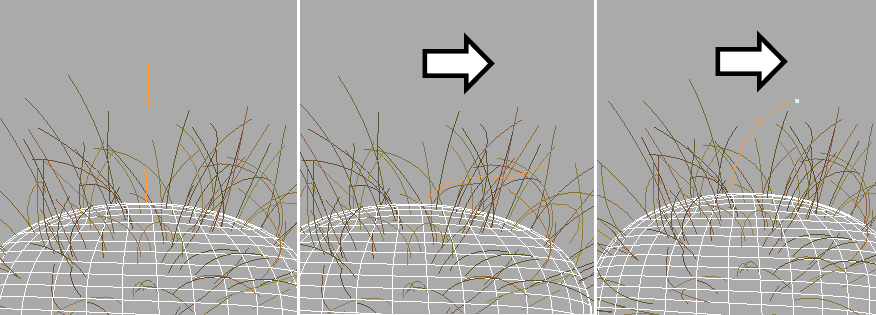
Left: Hair guide before styling
Center: Translating while Select Whole Guide is active
Right: Translating while Select Hair By Ends is active
Once you've made a selection, typically you will click Hair Brush (also in the Styling group, to the left of Select), and then use the brush in conjunction with one of the tools at the bottom of the Styling group: Translate, Stand, Puff Roots, Clump, Rotate, or Scale.
While you style, only selected guides are affected, and in addition, only guides that fall within the brush area are affected at any given time. You can change the brush size using the slider in the Styling group, or by holding down  +
+ and dragging the mouse.
and dragging the mouse.
The Hair Cut tool on the Styling rollout (between Hair Brush and Select) cuts hair guides by scaling them based on the brush location.
Interface

Click a group box in the image to jump to the description of the corresponding settings.
- Style Hair / Finish Styling
-
Click Style Hair to begin styling. Click Finish Styling to turn off styling mode. When you turn this button on, a brush is immediately available and by default the active tool is Translate. Turning on Style Hair accesses the Guides sub-object level in the Selection rollout and selects all guides.
Selection group
-
 Select Hair by Ends
Select Hair by Ends -
You can select only the vertex at the end of each guide hair.
-
 Select Whole Guide
Select Whole Guide -
(The default.) Selecting any vertex on a guide hair selects all vertices on the guide hair. When you first turn on Style Hair, Hair activates this mode and selects all vertices of all guide hairs.
-
 Select Guide Vertices
Select Guide Vertices -
You can select any vertices on a guide hair.
-
 Select Guide by Root
Select Guide by Root -
You can select only the vertex at the root of each guide hair, and doing so selects all vertices on the guide hair.
- Vertex display drop-down list
-
Chooses how selected vertices are displayed in viewports.
- Box Marker (The default.) Selected vertices display as small squares.
- Plus Marker Selected vertices display as small plus signs.
- X Marker Selected vertices display as small Xes.
- Dot Marker Selected vertices display as dots.
- Selection Utilities
-
The buttons labeled “Selection Utilities” are for handling selections.
-
 Invert Selection
Invert Selection -
Inverts the vertex selection.
Keyboard shortcut:
 +I
+I -
 Rotate Selection
Rotate Selection -
Rotates the selection in space.
-
 Expand Selection
Expand Selection -
Expands the selection by growing its area incrementally.
-
 Hide Selected
Hide Selected -
Hides selected guide hairs.
Tip: If interactive styling in viewports seems to be slow, try hiding those guides you aren't working on. -
 Show Hidden
Show Hidden -
Unhides any hidden guide hairs.
Styling group
-
 Hair Brush
Hair Brush -
(The default.) In this styling mode, dragging the mouse affects only selected vertices within the brush area.
While Hair Brush is on, a brush gizmo is displayed in viewports. In the active viewport, the brush appears as a circle, but as you can see in the other viewports, the brush is actually a three-dimensional cylindrical region.
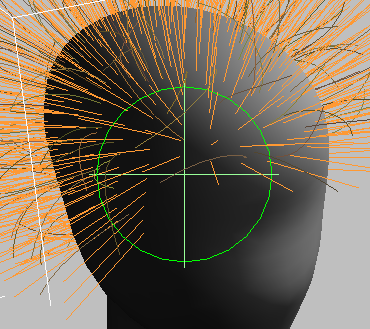
In the active viewport, the brush appears to be a circle.
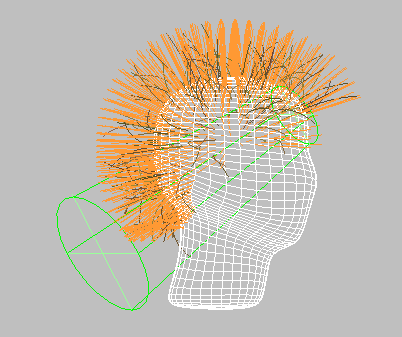
Inactive viewports show the brush to be a cylindrical region.
-
 Hair Cut
Hair Cut -
Lets you trim the guide hairs. To cut hair, follow this suggested procedure:
- In Selection mode, choose any selection method.
- Drag the mouse to select guide hairs to trim.
-
 Turn on Hair Cut.
Turn on Hair Cut. - Resize the brush using the slider.
- Position the brush circle over hairs to cut, and then click to cut the hairs. Hairs with vertices inside the brush circle are shortened so that their endpoints touch the brush circle.
Note: Cutting hair doesn't actually remove vertices; it only scales the guide hairs. You can restore guide hairs to their original length with Scale or one of the Pop commands.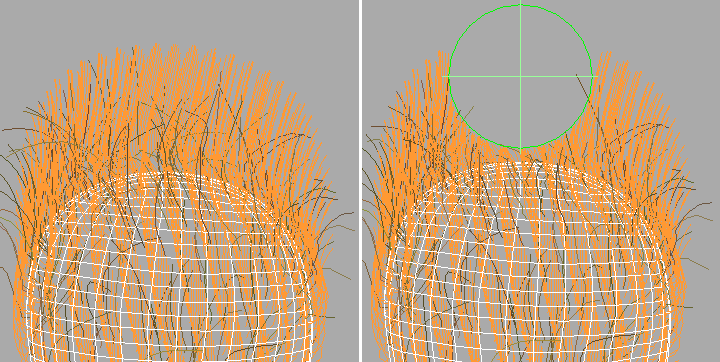
Left: Hair guides before cutting
Right: Hair guides after cutting
-
 Select
Select -
Activates a mode where you can use 3ds Max selection tools to select guide vertices according to the constraints chosen in the Selection group (Whole Guide, Ends, and so on).
- Distance Fade
-
Available only for Hair Brush. When on, the effect of brushing fades toward the edges of the brush, giving a gentler effect. When off, brushing affects all selected vertices equally, giving a hard-edged effect. Default=on.
- Ignore Back Hairs
-
Available only for Hair Brush and Hair Cut. When on, hairs on back faces are not affected by the brush. Default=off.
- Brush size slider
-
Drag this slider to change the size of the brush.
Keyboard shortcut:
 +
+ +drag
+drag The styling buttons below the Brush Size Slider are available only while Hair Brush is on.
-
 Translate
Translate -
Moves selected vertices in the direction that you drag the mouse.
-
 Stand
Stand -
Pushes selected guides toward a perpendicular orientation to the surface.

Left: Guide hairs before styling with Stand
Right: Guide hairs after styling with Stand (on the right)
-
 Puff Roots
Puff Roots -
Pushes selected guide hairs toward a perpendicular orientation to the surface. The bias for this tool is closer to the root of the hair than to the endpoint.

Left: Hair guides before puffing roots
Right: Hair guides after puffing roots
-
 Clump
Clump -
Forces selected guides to move towards each other (drag mouse rightward) or farther apart (drag mouse leftward).

Left: Hair guides before clumping
Right: Hair guides after clumping (at the right)
-
 Rotate
Rotate -
Rotate or swirls guide hair vertices around the cursor location (at the center of the brush).

Left: Hair guides before rotating
Right: Hair guides after rotating (at the forelock)
-
 Scale
Scale -
Scales selected guides larger (drag mouse rightward) or smaller (drag mouse leftward).

Left: Hair guides at original lengths
Right: Hair guides after scaling shorter
Utilities group
-
 Attenuate Length
Attenuate Length -
Scales selected guides according to the surface area of underlying polygons. This is useful, for example, in applying fur to an animal model, which typically has smaller polygons in areas with shorter hair. For example, the polygons on an animal's paws are usually smaller than the ones on the chest, and the chest fur tends to be longer.
-
 Pop Selected
Pop Selected -
Pops selected hairs out along the surface normal.
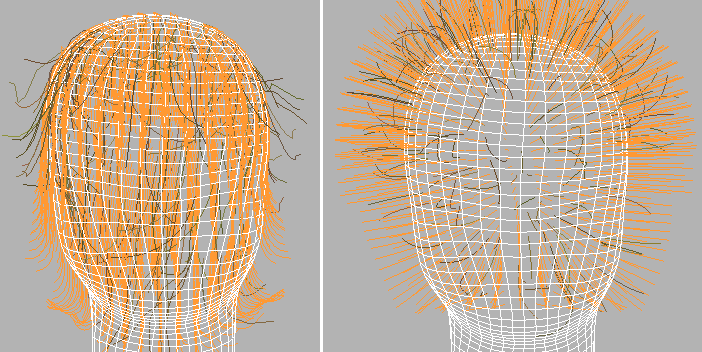
Left: Hair guides before using Pop Selected
Right: Hair guides after using Pop Selected
-
 Pop Zero-Sized
Pop Zero-Sized -
Works like Pop Selected, but only operates on zero-length hairs.
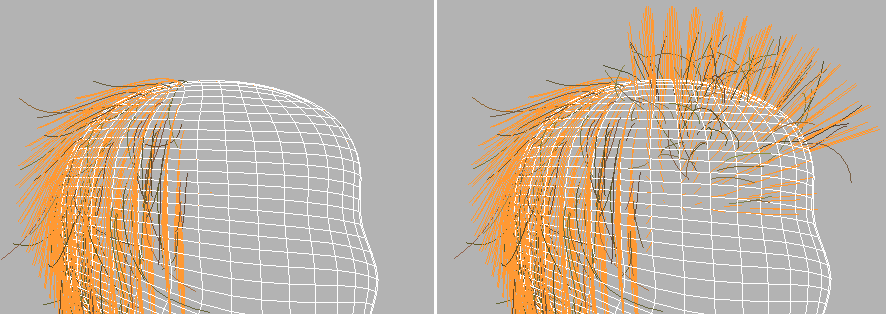
Left: Hair guides on top of head were scaled to zero length.
Right: Using Pop Zero affects only the zero-length hair guides.
-
 Recomb
Recomb -
Makes a guide parallel to the surface, using the guide's current direction as a hint.
Here’s a suggested procedure: Turn on Hair Brush, select guides using Select Whole Guide, and then move the guides around not worrying about skin penetration or hair shape. You’re just trying to indicate the direction of the hair flow. Click Recomb frequently, and you will soon start to see hair flowing smoothly wherever you want it to. Once you have this flow, you can do your other styling. With the Recomb tool, you probably won't need to use Comb Away. Once you have the flow as you like it, you can go in and start styling in scale, cut guides, and move some of the tips around, “shaping” or “styling” the hair.

Left: Hair guides in their default position
Right: Hair guides after clicking Recomb
-
 Reset Rest
Reset Rest -
Performs an averaging of hair guides using the growth mesh’s connectivity.
This function is particularly useful after using Recomb.
-
 Toggle Collisions
Toggle Collisions -
When on, styling takes hair collisions into account. When off, styling ignores collisions. Default=off.
For collisions to be used while styling, you need to have already added at least one collision object using the Dynamics rollout. If no collisions are specified, this button has no effect.
Tip: If you collisions are enabled and styling interaction seems slow, try turning off Toggle Collisions. -
 Toggle Hair
Toggle Hair -
Toggles viewport display of generated (interpolated) hair. This doesn't affect display of the hair guides. Default=on (hair is displayed).
-
 Lock
Lock -
Locks selected vertices with respect to the orientation to and distance from the nearest surface. Locked vertices can be selected, but they can't be moved.
This is useful for creating different types of hair shapes. For example, to make a braid, you would comb hair down some straight tubes, and then lock the vertices to the tubes. Then, in 3ds Max, when you twist the tubes, the hairs will follow. Locked vertices are no longer dynamic, although they will follow whatever the surface does, but if other vertices on the same guides aren't locked, they can still move freely, as usual.
-
 Unlock
Unlock -
Unlocks all locked guide hairs.
-
 Undo
Undo -
Reverses the most recent action.
Keyboard shortcut:
 +Z
+Z
Hair Groups group
-
 Split Selected Hair Groups
Split Selected Hair Groups -
Splits the selected guides into a group. This can be useful for creating a part or a cowlick, for example.
-
 Merge Selected Hair Groups
Merge Selected Hair Groups -
Recombines selected guides.
If you don't use Split Selected Hair Groups, then when you render hair, the generated hairs are interpolated across a styled part. When Split Selected Hair Groups is on, there is no interpolation between the split group and other hairs. To remove this effect and make the part less “clean,” click Merge Selected Hair Groups.